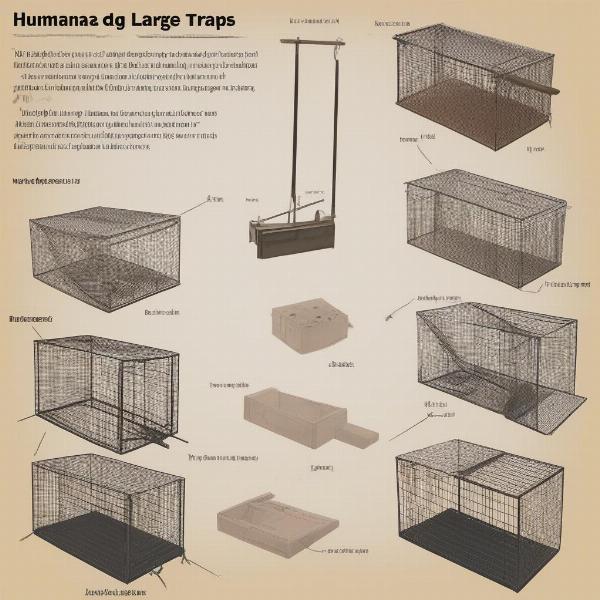Large humane dog traps are essential tools for rescuing stray, lost, or injured dogs without causing them harm. These traps offer a safe and effective way to capture dogs, ensuring their well-being and facilitating their return home or placement in a shelter. Understanding the different types of traps, how to use them correctly, and the importance of humane practices is crucial for anyone involved in dog rescue or animal control.
Choosing the Right Large Humane Dog Trap
 Types of Large Humane Dog Traps
Types of Large Humane Dog Traps
Selecting the appropriate trap depends on several factors, including the size and temperament of the dog, the environment where the trap will be placed, and local regulations. Common types include box traps and drop traps. Box traps are typically rectangular enclosures with a spring-loaded door that closes when the dog steps on a trigger plate. Drop traps, on the other hand, consist of a net or cage that falls over the dog when activated. For larger breeds, a sturdy, well-constructed trap is essential. Consider traps made of heavy-gauge wire mesh with reinforced doors and secure latches.
Setting Up and Baiting a Humane Dog Trap
Placement is key to successfully trapping a dog. Choose a location that is familiar to the dog, sheltered from the elements, and away from high-traffic areas. Camouflaging the trap with natural materials like leaves or branches can help make it less conspicuous. When it comes to bait, canned hot dogs are often irresistible to dogs. Other options include cooked chicken, canned tuna, or strong-smelling dog treats. Place the bait towards the back of the trap to encourage the dog to fully enter before triggering the door.
Ensuring Humane Trapping Practices
Humane trapping prioritizes the dog’s well-being throughout the entire process. Regularly check the trap, especially in extreme weather conditions, to minimize the dog’s stress and ensure its safety. Once the dog is trapped, approach calmly and speak in a soothing voice to avoid frightening it. Cover the trap with a blanket or towel to create a more secure and calming environment. Never attempt to force the dog out of the trap. Instead, transport the trapped dog to a local animal shelter or rescue organization where it can receive proper care and attention.
Dr. Emily Carter, a veterinarian specializing in animal welfare, emphasizes the importance of humane trapping: “Using humane methods not only minimizes stress for the animal but also builds trust, making it easier to provide further care and find them a loving home.”
What to Do After Trapping a Dog
After successfully trapping a dog, it’s crucial to act responsibly. Contact your local animal control or a reputable rescue organization. They have the expertise to handle the situation and can help reunite the dog with its owner or find it a suitable new home. If the dog appears injured or distressed, seek immediate veterinary attention.
“A large dog trap is just the first step in a dog’s journey back to safety,” says John Miller, a seasoned animal rescue volunteer. “Patience, compassion, and collaboration with local animal welfare groups are essential for ensuring a positive outcome.”
Conclusion
Large humane dog traps are invaluable tools for rescuing dogs in need. By understanding how to choose, set up, and use these traps responsibly, we can ensure the safe and humane capture of stray or lost dogs, giving them a second chance at a happy life. Remember to always prioritize the dog’s welfare throughout the process and collaborate with local animal shelters or rescue organizations for the best possible outcome.
FAQ
-
What is the best bait for a large humane dog trap? Strong-smelling foods like canned hot dogs, cooked chicken, or canned tuna are often effective.
-
Where should I place a dog trap? Choose a location familiar to the dog, sheltered from the elements, and away from high-traffic areas.
-
What should I do if I trap an injured dog? Contact animal control or a veterinarian immediately.
-
How often should I check a dog trap? Check the trap regularly, especially in extreme weather, to ensure the dog’s safety and minimize stress.
-
Can I release a trapped dog myself? It’s best to contact animal control or a rescue organization to handle the release and ensure the dog receives appropriate care.
-
Are there different sizes of humane dog traps? Yes, choose a trap size appropriate for the dog you are trying to capture.
-
What is the difference between a box trap and a drop trap? A box trap has a spring-loaded door, while a drop trap uses a net or cage that falls over the dog. Dog catching cage is another way to refer to these helpful tools.
ILM Dog is a leading online resource for dog owners and enthusiasts worldwide. We provide expert advice and information on all aspects of dog care, from breed selection and training to health, nutrition, and dog collars for large dogs. We are dedicated to promoting responsible dog ownership and improving the lives of dogs everywhere. Contact us at [email protected] or +44 20-3965-8624. ILM Dog is here to support you and your furry friend every step of the way.